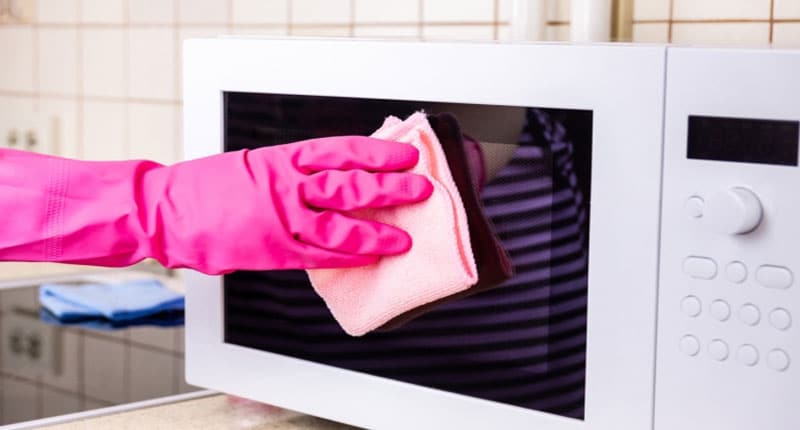
In today’s fast-paced world, the microwave has become an indispensable appliance in our kitchens. It’s our go-to solution for reheating leftovers, defrosting frozen foods, and even cooking quick meals. However, just like any other kitchen appliance, a microwave requires regular cleaning and proper care to ensure its longevity and safety. Let’s dive into some practical tips on how to keep your microwave clean and safe.
Why Cleaning Your Microwave is Important
Cleaning your microwave isn’t just about maintaining its appearance; it’s also crucial for health and safety reasons. Food spills, grease, and residues can accumulate over time, creating a breeding ground for bacteria and even affecting the microwave’s performance. Regular cleaning prevents unpleasant odors, ensures even heating, and reduces the risk of fires caused by residue buildup.
Essential Cleaning Supplies
Before diving into cleaning, gather your cleaning supplies. You’ll need:
- A microwave-safe bowl
- Water
- White vinegar
- Dish soap
- Microfiber cloth or sponge
- Soft bristle brush
Safety First: Unplugging and Cooling Down
Before starting the cleaning process, ensure the microwave is unplugged to eliminate any risk of electrical shock. Additionally, let the microwave cool down if it was recently in use, as cleaning a hot appliance can be hazardous.
Step-by-Step Cleaning Guide
Pre-Cleaning Preparation
Begin by removing any loose debris or visible food particles from the microwave. This prevents them from spreading while cleaning.
Cleaning the Exterior
Use a damp cloth with mild dish soap to wipe down the exterior surfaces, including the control panel and door. Avoid using abrasive materials that could scratch the surface.
Tackling the Interior
-
- Fill a microwave-safe bowl with a mixture of water and vinegar in a 1:1 ratio.
- Place the bowl in the microwave and heat on high for 5 minutes. The steam created will help loosen grime.
- Carefully remove the bowl (it will be hot), and wipe down the interior with a microfiber cloth or sponge. Pay special attention to the ceiling, walls, and turntable.
Dealing with Stubborn Stains
For stubborn stains or dried-on food, dip a soft bristle brush in a mixture of water and baking soda. Gently scrub the stained areas to avoid damaging the microwave’s interior.
Dos and Don’ts of Microwave Cleaning
- Do clean up spills immediately after they occur.
- Do cover your food with microwave-safe lids or paper towels to prevent splatters.
- Do place a microwave-safe cup of water alongside your food to create steam and avoid food from drying out.
- Don’t use harsh chemicals or abrasive scrubbers that could damage the microwave.
- Don’t let food residue accumulate over time.
- Don’t immerse the microwave in water, as it’s an electrical appliance.
Maintaining a Safe Microwave
Regular inspection is essential. Check the door seal for any wear and tear that could lead to radiation leakage. If you notice any issues, it’s best to consult a professional technician.
Covering Food: Preventing Splatters
Placing a microwave-safe cover or paper towel over your food prevents messy splatters, making your cleaning routine much easier. It also helps distribute heat evenly, ensuring your food heats uniformly.
Regular Inspection for Wear and Tear
Periodically check the power cord, plug, and door seal for signs of damage. If any issues are detected, avoid using the microwave until it’s repaired by a qualified technician.
Conclusion
In conclusion, keeping your microwave clean and safe isn’t just about aesthetics; it’s about ensuring proper functionality and preventing potential hazards. By following these cleaning and maintenance tips, you can enjoy the convenience of your microwave while keeping it in top-notch condition for years to come.
FAQs
Q1: Can I use bleach to clean my microwave?
- No, using bleach can damage the microwave and leave harmful residues. Stick to mild cleaning solutions.
Q2: How often should I clean my microwave?
- Ideally, give it a wipe-down after each use and a more thorough cleaning once a week.
Q3: Can I use metal utensils in the microwave?
- No, metal can cause sparks and fires. Stick to microwave-safe utensils.
Q4: Is it safe to microwave leftovers in plastic containers?
- Use microwave-safe containers labeled as such to prevent chemicals from leaching into your food.
Q5: What should I do if my microwave sparks?
- Immediately turn off the microwave, as sparks indicate a potential issue. Contact a technician for inspection.
